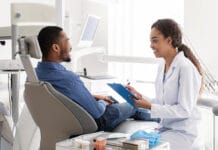In the early days of the dental hygiene profession, a large effort was expended on hygienists who worked in elementary schools. Hygienists distributed information on dental disease prevention throughout the public.2 Over time, the dental hygiene career has evolved and grown. With stricter laws and regulations concerning supervision, dental hygienist are now typically employed in general and specialized dental practices.
However, the need for public dental services and prevention is as great a need as ever. With many Americans struggling to access and afford dental care, dental clinics for the underserved are on the rise.1
Throughout the country, differing levels of service organizations and clinics work to serve those without access to dental care. At some point in every dental clinician’s career, we have all probably considered a job in public health. However, other clinicians are sometimes hasty to recommend choosing another route. While a portion of the information they share may be true, they often paint a picture that is incorrect when it comes to dental public health clinics.
Below are the do’s and don’ts of public health dentistry:
Don’t believe that it is a high-stress job based on clinics being overscheduled.
In most public health clinics, the goal is to treat patients and to give them every opportunity to access care. This usually translates into allowing late arrivals and keeping unconfirmed patients on the schedule. To make up for this, many clinics operate by scheduling a large number of patients, with the assumption that more than half will not show up.
Do have a plan of how you will handle the pressure if these patients do show up.
The schedule will take care of itself most of the time. However, there will be times that multiple patients do show up. Planning in advance for this, and having rooms set up will help to make your day go more smoothly.
Try having a conversation with patients explaining that you could not get a confirmation from them, which caused a delay in their appointment time. This may help to have more confirmed appointments in the future.
Don’t wait to set up until your patient arrives simply because you assume they will not show up.
Doing this will cause inevitable stress that could easily be avoided.
Do have your room and trays ready.
Always have your room ready to go. This will alleviate stress if a patient does arrive.
Don’t assume that your patient simply does not care about his or her oral health.
There are multiple limitations that influence patients and their capabilities in taking care of their home care and dental needs. From finances to disabilities, keep an open mind of what may be limiting your patients and work with your patients to overcome them.
Do treat your patients with respect.
Regardless of financial status or disability, work to respect your patients and remember that they have the right to be in control of their own oral health.
Don’t teach oral hygiene instructions as one-size-fits-all.
With differing patient backgrounds and limitations comes the need for customized home care instructions. While the ideal recommendation for a patient may be an electric toothbrush or water flosser, understand that financial limitations and physical limitations do exist.
Do customize oral hygiene instructions.
Instead of recommending the absolute ideal home care instructions or devices that your patient may not be able to accomplish or afford, work with your patients to come up with a home care routine that is realistic for any limitations they may have.
Don’t assume patients get substandard care in public health.
A common misconception is that public health providers do not uphold a high standard of care.
Do provide the highest standard of care for your patients.
Remember that as a clinician, you set your own standard, and therefore must work to ensure you are giving the highest level of care you can provide.
Don’t believe that public health facilities have substandard equipment.
Another common misconception surrounding public health employment is the belief that these clinics do not have high-quality equipment.
Do understand that most public health clinics work hard to provide the highest level of equipment.
Many clinics follow strict accreditation guidelines that ensure that they provide modern and safe equipment.
And finally,
Don’t assume that public health is not for you because of someone else’s opinion.
I will never forget the dentist who told me that public health would be the worst decision I ever made. Never make a decision based on someone else’s opinion or experiences.
Do consider working in public health.
I promise you will not regret it.
*Disclaimer: These do’s and don’ts are based on my own experience in public health and are shared in an attempt to motivate and inspire other hygienists to work with the public.
References
- AHS-6.3 Data Details. (n.d.). Retrieved from https://www.healthypeople.gov/node/3984/data_details
- Themes, U. (2015, January 14). 1: Historical Perspectives on Dental Hygiene and Periodontology. Retrieved from https://pocketdentistry.com/1-historical-perspectives-on-dental-hygiene-and-periodontology/











